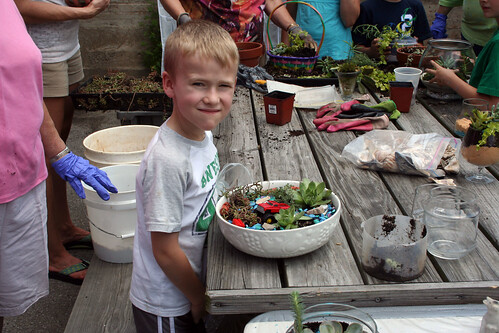If you’re ready to delve into the fulfilling world of gardening but don’t know how to start, use our informative guide. Planting flowers, fruits, and vegetables don’t have to be complicated or time-consuming — and everyone in the family can join in the fun, young and old. So kick start your easy-care backyard plot today with these handy tips and advice.
Why Should You Plant a Family Garden?

“Hill & Valley GC, Luray, VA Youth Dish Garden Workshop” licensed under CC BY-ND 2.0 via Flickr by National Garden Clubs
Whether you’re sowing your first crop of lettuce or adding a few flower pots to a sunny windowsill, gardening can be a fun and easy activity for children as young as two. One of the best things about this rewarding hobby is that it comes with many benefits, from fresh-grown, nutritious ingredients to put on the table to a sense of accomplishment for a job well done.
Sowing a garden does more than get you and the kiddos outside in the fresh air. According to a study published in 2018, gardening is beneficial to your body and mind. Researchers have proven that a regular dose of soil, water, sunshine, and plants can reduce stress, blood pressure, and pulse rate while boosting your well-being.
Tips For Creating a Low Maintenance Garden
Stop dreaming of glorious rows of vegetables and get started the right way. With a bit of planning, your first harvest could be right around the corner. Remember to start small, with one or two raised beds about 8-feet square. Only plant one or two varieties your first season, so you don’t overwhelm you and the kids with extra chores. You can always expand as your confidence level and skills grow.
Be selective about which plants you cultivate. Look for those that are low-maintenance and only grow foods that your family already eats. For example, a habanero pepper plant is relatively easy to farm. However, is your third grader really going to eat this brutally spicy chili? On the other hand, if your fridge is routinely out of strawberries, that might be the ideal crop to cultivate.
Expert gardeners also recommend using mulch. It’s a terrific product to have on your side because it reduces both weeding and watering requirements, two of gardening’s most intensive chores. Depending on your crop, there are many types of mulch you can use. Today’s modern tech can also help take some of the load off. Soaker hoses, automatic timers, and drip systems are convenient ways to ensure your plants get the water they need, whether your family is at home, school, or the office.
Enjoy Low Maintenance Vegetables
Most budding farmers naturally turn to vegetables their first growing season, and for good reasons. There are many plants that fall under this popular category that don’t require a ton of care — and they taste delicious.
Some of these easy-to-grow vegetables also produce large yields, so take that into consideration when deciding how many seeds to sow. Vines like zucchini are prolific producers, and one seed may produce enough produce to satisfy your family’s needs. In fact, one of the common mistakes beginners make is planting too many vegetables. West Chester, Ohio, is in Hardiness Zones 6a. So, try one or two of the following varieties for the best success:
- Lettuce.
- Green beans.
- Peas.
- Kale.
- Cucumbers.
Plant Fuss-Free Fruits
Do you want to enjoy freshly harvested fruits without all the fuss? Even if your backyard lacks space or you simply don’t want to spend your day pulling weeds, there’s hope. Mother nature offers many fruits and berries that are so easy to bring to harvest, even your children can handle the duty after school.
Consider using a container to grow your fruit plants. It’s the perfect solution if you want to nurture a few plants indoors in a small space. Good drainage is an important consideration, as are the nutrients. Feed your plants by adding fertilizer every week or two, depending on the variety. Not all kinds of fruits grow well in a container, though, so pick from this list:
- Strawberries.
- Blueberries.
- Tomatoes.
- Watermelon.
- Cantaloupe.
Sow a Few Easy-Care Herbs
If you are new to growing plants, herbs are another excellent choice. They are one of the easiest plants for first-time gardeners to cultivate. A top reason to start with herbs is that they are so versatile. Many varieties are happy inside or out, in a container, or sown directly in the ground. They may be content basking in the sun on your deck or hanging out on a shady windowsill.
If you have a young chef at home, encourage them to grow their own fresh seasonings. Some of the best options to start with include staples like:
- Parsley.
- Mint.
- Cilantro.
- Dill.
- Chives.
Dig Up Delicious Roots
Root crops are truly some of the best treasures in the garden. While most varieties require very little work, they don’t compete well with weeds, so remember to mulch. You’ll also have to thin your root crops and keep your beds well watered with soakers or an automatic system. For the least fussy root plants, we recommend some popular foods like:
- Potatoes.
- Carrots.
- Radishes.
- Beets.
- Parsnips.
Stop and Smell the Flowers
Flowers are a beautiful addition to any family’s garden plot, and they smell good, too. If you want to add an attractive splash of color to your garden, add a few blooms. Choose a sunny location and give your flowers plenty of room to grow. There are several hardy options that novices will find hard to kill. Try these resilient, low-maintenance flowers and watch you and your kiddo’s green thumb grow:
- Sunflowers.
- Zinnia.
- Marigolds.
- Pansies.
- Impatiens.
There you have it! Crème de la Crème of West Chester just provided you with this guide to planting a rewarding, low-maintenance garden. Whether you sow vegetables or flowers, you’ll find many plants that do well in Ohio. Let us know what plants your family enjoys putting in your garden. Drop us a line. We’d love to add your recommendation for other families to try.
